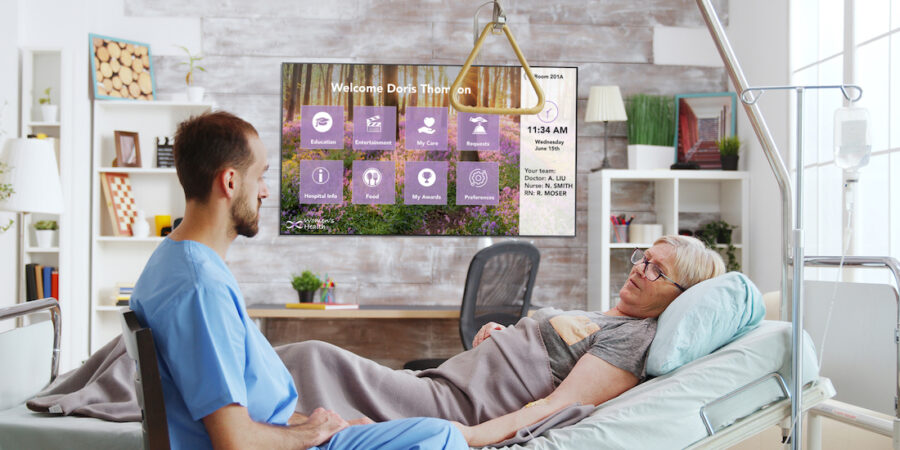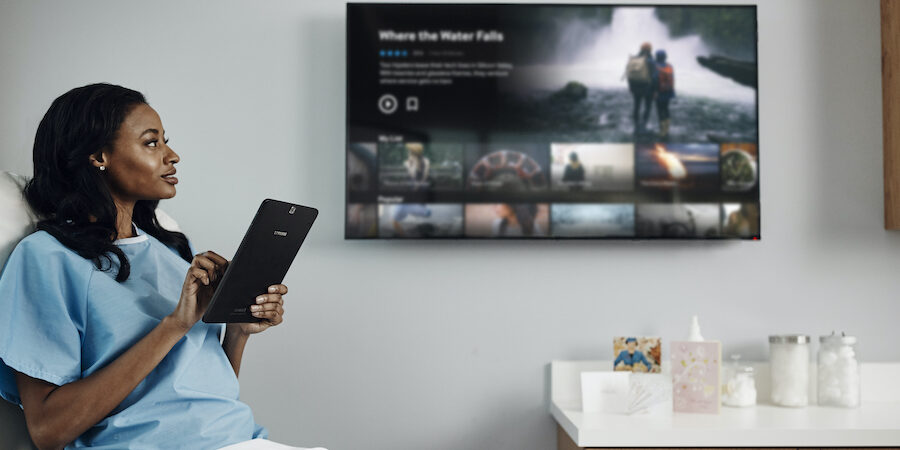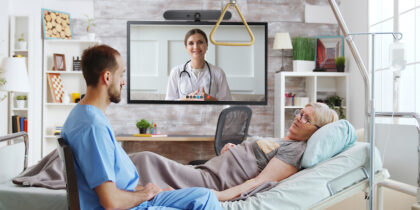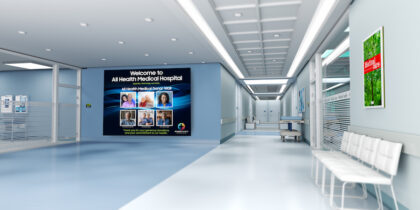The digital transformation of healthcare has radically changed hospital design. At the heart of this transformation lies the patient room, the anchor of the hospital. Like the modern medical complex, the modern patient room is streamlined with integrated and automated digital display solutions that enhance clinical workflows while supporting patient engagement, satisfaction and safety. Here’s how.
Account for integration
Dry-erase boards have, for decades, been a standard feature of most patient rooms. But these boards need to be updated manually every shift to include the names of everyone on the patient’s care team, as well as other pertinent information, such as dietary restrictions, medications and discharge date. Over time, it’s easy for this handwritten information to go out of date and become illegible. Plus, having to constantly make these updates by hand takes staff away from important clinical tasks.
Today’s patient room now includes a digital whiteboard that updates automatically, drawing on information from the electronic health record (EHR) and shift assignment software. That means the care team, patients and families will automatically get the most current information at the point of care.
Similarly, a real-time location system (RTLS) ensures that patients and their loved ones know which staff member has entered the patient room at any given time. Each clinician and employee will wear a badge that communicates with the healthcare TV, automatically displaying their name and role as they enter the room. An integrated RTLS also ensures that the right information goes to the right care team member at the right time.
Screens located above the bed behind the patient can simultaneously display information relevant to whichever team member is checking on them. Their nurse, for example, would see different information than the attending physician, respiratory tech and dietitian.
Plan for telepresence
Telehealth technology allows for better monitoring and easier access to care. Interactive displays in patient rooms, such as Samsung Interactive Pro, often support web cameras to facilitate virtual appointments, allowing caregivers to monitor patients remotely and still speak with them face-to-face. With connected diagnostics, clinicians can make accurate assessments over a video call.
Create the patient room of the future — today
Explore key technologies for enhancing patient experience and care while supporting staff. Download Now
For patients who are fall risks, cameras can function as virtual bed rails, alerting the care team if they attempt to get out of bed alone. But in-room cameras and telehealth solutions aren’t only for dire situations: They allow for virtual family visits and real-time, interactive education sessions with patients and their caregivers before discharge, with support from language translation services if needed.
Support patient engagement
A digitally streamlined patient room doesn’t just support clinical workflows; it also enhances the patient experience. In addition to the welcome distraction the entertainment provides, the in-room TV can provide diagnostics, data and other key information. Empowered with this knowledge, patients can experience less of the discomfort and anxiety many struggle with during a hospital stay. Entertained and engaged patients are less likely to call the nurses’ station. The reduction in stress may also foster more positive outcomes.
Patient rooms might also have bedside tablets, which they can use to view their records and prescriptions, see who’s on their care team and communicate with nurses, doctors and other hospital staff. Rather than pushing the call button to ask for something simple like another blanket, patients can request these services directly from their tablets, so the nurses’ station no longer needs to work like a switchboard. This reduces the nurses’ administrative burden, eases alarm fatigue and allows them to work at the top of their license.
On the same tablet, an automated message can ask patients if their room is quiet enough for them to sleep and make the appropriate changes. Patients can also adjust the room’s temperature, lighting and window shades with the touch of a button — all to create a better, more comfortable experience.
Think beyond the room
The patient room is just the beginning. Digital displays can improve clinical efficiency across the entire facility, such as in these use cases:
- Nurses stations: Equipping nursing stations with large, centralized USB-C monitors provides efficient, all-in-one information dashboards. Because they require fewer cables, these monitors easily fit on nursing carts.
- Outside the door: Smaller displays outside each patient room ensure that clinicians, staff and visitors are informed of the patient’s dietary restrictions, relevant allergies and preferred language, as well as all safety protocols required to enter the room.
- Waiting rooms: Visitors can track their loved one’s status on an updated waiting room monitor. Uncertainty leads to questions: Are they still in the operating room? For how much longer? When these questions are answered promptly, the waiting room becomes a much less stressful place.
- Wayfinding: Touchscreen maps show patients and visitors exactly where they need to go, avoiding frustration and freeing up busy hospital staff from the need to constantly repeat directions.
- Marketing and development: Hospitals can install a microLED video wall to recognize donors and share brand stories.
Keep design front of mind
Implementing these digital solutions will require not only adequate space but smart design. Hospital architects and engineers will need to make sure that every element works together seamlessly and is scalable because technology is constantly evolving. When digital displays are properly deployed and fully integrated, patients and their loved ones are more engaged and at ease, future-proofing high-quality service to patients for years to come.
Learn more about how digital displays are easing pain points and transforming clinician and patient experiences in our free guide. Also, discover the many ways healthcare TVs improve the patient experience.








